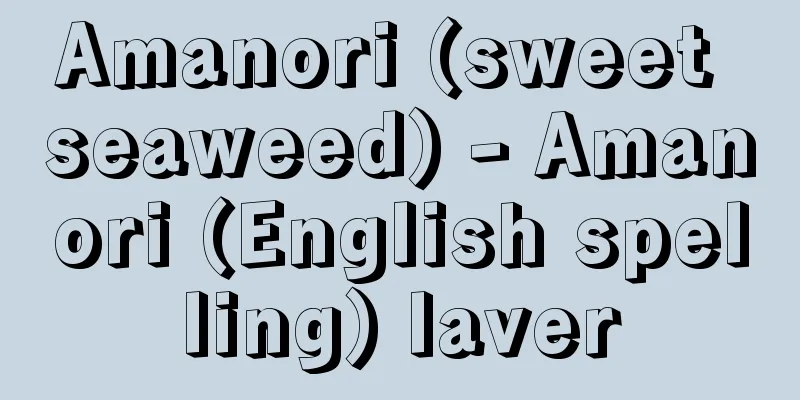Firefighter - Hikeshi

|
Firefighting organizations established in each city during the Edo period, or people who belonged to such organizations. In the early Edo period, there were no firefighting organizations, and when a fire broke out in Edo Castle or a samurai residence, the shogunate's large government unit or rifle unit would be dispatched to the scene, but they would not be involved in fires in town houses. The great fire of 1657 (Meireki 3) prompted the development of a firefighting and fire prevention system, and an organized firefighting system was realized. Edo's firefighting organizations can be broadly divided into samurai-affiliated daimyo fire brigades, regular fire brigades, spot fire brigades, direction fire brigades, and town fire brigades. [Minami Kazuo] Firefighters for the samurai(1) Daimyo Firefighters In the early Edo period, firefighting was the responsibility of daimyo. In the beginning, whenever a fire broke out, a shogunate official or daimyo would be ordered to put out the fire by letter. It is said that daimyo firefighters were first organized in 1643 (Kan'ei 20). In September of that year, the shogunate organized 16 daimyo into four groups, and ordered them to mobilize at a ratio of 30 people per 10,000 koku, with each group taking a 10-day shift. It seems that the daimyo closest to the source of the fire would take part in the firefighting, regardless of whether it was a samurai residence or a town house. After the Great Fire of Meireki (1657), when firefighting came to be mainly carried out by regular firefighters and hatamoto, the shogunate reduced its responsibilities and only focused on firefighting in the vicinity of Edo Castle and feudal domains. (2) Jyobikeshi This was a fire brigade under the direct control of the shogunate, and is said to have existed in 1650 (Keian 3), but details are unclear. In 1658 (Manji 1), the year after the Meireki fire, the shogunate paid 300 men's stipends to four hatamoto vassals, including Kondo Hikokuro, who was a member of the Yoriai, as a salary for employing fire brigade personnel, and assigned six yoriki (police officers) and 30 doshin (police officers) to each of them. They were then given official residences in four locations: Kojimachi Hanzomon, Iida-cho, Ichigaya Sanai-zaka, and Ochanomizu, and the wives and children of the Jyobikeshi, as well as yoriki (police officers), doshin (police officers) and fire brigade personnel, were allowed to live and work within the residences to form an official fire brigade. They were tasked with extinguishing fires not only in samurai estates, but also in ordinary town houses. Thus, these Jobikeshi succeeded the Daimyo-bikeshi and played an important role in fire prevention in the city until the Machi-bikeshi were established during the Kyoho era (1716-1736). After that, the number of groups gradually increased, reaching 10 in 1662 (Kanbun 2), and 15 in 1695 (Genroku 8), but in 1704 (Hoei 1), five groups were removed to make it 10, and since there were roughly 10 groups from then until the end of the Edo period, the Jobikeshi were also called Ten-person Firemen. The Hatamoto who served as Jobikeshi were said to be wealthy, with stipends of 3,000 to 4,000-5,000 koku, and they had official residences in 10 locations surrounding Edo Castle. Their locations were Yaesugashi, Akasaka Tameike, Hanzomon-gai, Ochanomizu, Surugadai, Akasakamon-gai, Iidabashi, Ogawamachi, Yotsuyamon-gai, and Ichigaya Sanai-zaka. Each mansion had a 3-foot-high fire watchtower with three fire watchmen on duty day and night, and was equipped with a drum, a bell, and wooden planks. Each mansion had six yoriki (one theory says there were 10), 30 doshin, and about 100 firemen called "gaen" (smoke-smoke). The "gaen" were always up and down in a large room (gaen room) within the mansion, and at night 10 to 15 of them slept with long logs as pillows. When a fire was reported, the sleepless watchman would wake the residents by hitting the end of a log with a mallet. They were disliked by the citizens because of their tyrannical nature, and they often clashed with the daimyo firemen and the town firemen. After 1819 (Bunsei 2), the regular firemen were only responsible for firefighting within the Edo Castle, and were only called out to town firefighting in the event of a conflagration caused by a strong wind. In 1855 (Ansei 2), two groups were eliminated, and in 1866 (Keio 2), four more groups were eliminated, and by the following year, 1867, only one group remained. (3) Local Fire Fighting The origin of local fire fighting is said to be when Morikawa Hanya Shigemasa was ordered in 1639 (Kan'ei 16) to protect Momijiyama Mausoleum in case of fire around Edo Castle. After the Kyoho era, one or two daimyo were assigned to important facilities related to the shogunate, such as Honmaru, Nishinomaru, Momijiyama, Fukiage viewing hall, Asakusa rice storehouse, Honjo rice storehouse, Kan'ei-ji Temple, Zojo-ji Temple, Yushima Seido, and Honjo Sarue lumber storehouse, to fight fires in case of fire. Fudai daimyo were assigned to major locations such as Edo Castle, while Tozama daimyo were assigned to surrounding areas such as Honjo. (4) Directional fire brigades and others The first direction fire brigades were formed in February 1657 (Meireki 3), immediately after the Meireki fire, when 12 feudal lords were divided into three teams, Sakurada, Yamanote, and Shitaya, and ordered to fight fires. After that, in the spring of 1711 (Shotoku 1), fires occurred frequently, so in February of the following year, 1712, the shogunate divided the area around Edo Castle into five districts and ordered 15 feudal lords with 30,000 to 100,000 koku of rice to be in charge of firefighting. In 1717 (Kyoho 2), the division of areas to be divided into four districts, east, west, north, south, and east, was revised, and 10 new feudal lords were added to this division. Since the regular fire brigades were rotated to prevent the fire from spreading after the arrival of the regular fire brigades, it can be said that the role of the direction fire brigades was auxiliary to the regular fire brigades. Furthermore, after December 1736 (Genbun 1), it was decided that the brigades did not have to be dispatched except in the case of a major fire or a fire upwind of Edo Castle. At the end of the Edo period, there were only two such groups. In the event of a major fire, the elder councilors would issue a letter of instruction to the daimyo to temporarily put out the fire, and these were called the "hosho fire brigade." In addition, there was the "Hatamoto Tobi Kabō Kumiai," which consisted of the hatamoto living in Banchō, Ogawachō, and Surugadai organizing fire brigade associations, with groups of 10 or 1-15 people each dispatching their retainers to fight the fire. There was also the "Kincho Kabō" (neighborhood fire brigade), which was organized privately by the daimyo for self-defense purposes. These were commonly known as the "Santō Kabō" (neighborhood fire brigade), as they fought fires within 3 to 5 chō of their respective residences. [Minami Kazuo] Town fire brigadeIn contrast to the firefighting organizations of the samurai, the firefighting organizations of townspeople under the supervision of the town magistrates were called machibikeshi. From 1658 (Manji 1), the year after the Meireki fire, several attempts were made to establish self-defense firefighting organizations by townspeople, either voluntarily or by order of the town magistrates. Despite this, they did not last long and hardly any organization was seen. During the time of the eighth shogun, Tokugawa Yoshimune, a major reform was carried out over the entire range of fire prevention measures, and in October 1718 (Kyoho 3), the town magistrate Ooka Tadasuke ordered each town headman to establish a machibikeshi association. However, it was said that the firefighting effect was poor due to the way the firefighting associations were divided, and in 1720 the associations were reorganized and organized into the "Iroha 47 Groups." The organization was made up of about 20 towns west of the Sumida River, divided into seven small groups based on their area, and named each group using the 47 characters I, Ro, and Ha (the characters He, Hi, and Ra were changed to Hyaku, Sen, and Man because they sounded bad). 16 groups were established in Honjo and Fukagawa, across the Sumida River. At this time, they were given flags and small flags, and each group had one or two flags on its flagpole as a sign. In 1730, the 47 groups were further reorganized into 10 large groups (later reduced to 8 groups) from the 1st to 10th groups (later, in addition to the 47 Iroha groups, a "Hon-gumi" was organized and added to the 3rd group, making it the 48 Iroha groups). The 16 groups in Honjo and Fukagawa were divided into three groups: Upper, Middle, and Lower, and the firefighting system under the control of the Edo magistrate was established here. At this time, the number of firefighters in each town was halved from 30 per town to 15, reducing the burden on the towns. Town firefighters were under the supervision of the town magistrate, and their work was carried out by the yoriki and doshin of the firefighter labor review office, but as an autonomous organization within the town, all expenses were borne by the town, with the majority of these being spent on labor allowances and firefighting equipment. In other words, at first, townspeople went to the scene of a fire as hard laborers and helped with firefighting work. They were called store laborers, and in reality, servants from large stores and back-store tenants were called in as laborers. These amateur firefighting efforts by ordinary townspeople were slow and ineffective, so each town began to hire construction workers and mix them with store workers. In general, firefighting in the Edo period was focused on destructive firefighting, so workers other than construction workers were not very useful, and construction workers naturally became the main force of town firefighters. Then, in 1787 (Tenmei 7), professional construction workers were mainly in charge of fire prevention, and store workers were only dispatched in the event of a major fire. The town magistrate's office wanted the ratio of construction workers to store workers to be 50/50, but the towns did not want to increase the financial burden, so in the end, they agreed to a realistic measure based on the burden capacity of each town, rather than a uniform ratio for all Edo towns. As a result, for example, the I group had 103 professional construction workers and 393 store workers, and the Segumi had 70 professional construction workers and 211 store workers. As a result of this measure, the kakae roofers became the central players in both name and reality among the town firefighters. There are town-held and association-held kakae roofers. In the case of the Segumi in 1787, five ladder carriers and ten ryudosui (water spout) carriers were association-held roofers. In other words, the laborers who exclusively handled the association's firefighting tools, such as ladders and water spouts, were association-held roofers, and their wages were shared by each town within the association. The remaining 55 were town-held roofers employed by each town. There were ranks within each group of town-held firefighters, such as the laborer head (todori), matomochi (carrier), ladder (kaiko) carrier, and hira (laborer). In October 1797 (Kansei 9), over 270 labor leaders were officially recognized by the town magistrate. Although the selection of these leaders was technically the authority of the town elders, the wishes of the laborers' office at the town magistrate's office were given great importance. It was customary for a leader to serve in this role for life until retirement. In addition, there were also run-in laborers, and when a vacancy occurred among the town-held laborers, it was filled from among the run-in laborers. In reality, the laborers were selected according to the preference of the town-held landlord, and once a settlement was reached between the labor leader and the town landlord, the matter was reported to the headman. There was a tendency for the town-held laborers' status to become a stock. The expenses related to firefighting borne by each town accounted for a high proportion of the town's needs, and were counted as one of the three misfortunes of landlords. In peacetime, roofers tended to be lazy, but also had a rough attitude and a chivalrous spirit, giving them a unique character that was typical of Edo people. This was not limited to Edo, but roofers were originally construction workers, and they were the main players in firefighting, which was a contradictory aspect. In other words, the larger the affected area, the more work they would have and the more income they would receive, so it cannot be denied that they tended to be more pleased with large fires than small ones. In 1852 (Kaei 5), the shogunate made the self-defense firefighting organizations that had existed within the towns of Edo be implemented by all towns. Each town was required to prepare various tools to put out small fires before the arrival of the town fire brigade, but due to the excessive burden, this was abolished in 1857 (Ansei 4). The town fire brigades in the Kyoto and Osaka region were also mainly made up of construction workers. In Osaka, there were five fire brigades made up of helpers, and in addition, each town had its own town fire brigade. In Kofu, a firefighting system was first established in 1660 (Manji 3), and by 1744 (Enkyo 1), about three town fire brigades including construction workers had been established. [Minami Kazuo] "The Establishment and Development of the Edo Firefighter System" by Ikegami Akihiko (included in "Research on Edo Townspeople Vol. 5" edited by Nishiyama Matsunosuke, 1978, Yoshikawa Kobunkan)" ▽ "Edo Firefighter Chronicles" edited by Fujiguchi Togo (1962, Soshisha)" ▽ "400 Years of the History of Firefighting" by Uotani Masuo (1965, Zenkoku Kajo Horei Publishing)" ▽ "Fire Fighting" by Minami Kazuo (included in "Lecture Series on Japan's Feudal Cities Vol. 2" 1983, Bunichi Sogo Publishing) [Reference] | |A nishiki-e (colored woodblock print) depicting the "Iroha 48 Groups." The 48 groups (including the Iroha 47 Groups and later the "Hon-gumi" Group) were organized into 10 large groups, and each town in Edo was assigned to one of the groups. "Edo Town Firefighters" by Utagawa Yoshitsuna, triptych, owned by the National Diet Library . Town fire brigade Firefighting tools depicted in omochae. In addition to cinderblocks, sashimata, ladders, and dragon-shaped water spouts, other items include kimonos, lanterns, hanten coats, and hoods. "Shinban Teyuu Kaseki Doguzu" (New Edition of Hand-Played Firefighting Tools), held at the National Diet Library . Fire extinguishing tools from the Edo period Source: Shogakukan Encyclopedia Nipponica About Encyclopedia Nipponica Information | Legend |
|
江戸時代、各都市に設けられた消防組織、あるいはその組織に属する人。江戸時代初期には消防組織はなく、たとえば江戸城内や武家屋敷に火災が発生すると、幕府の大番組や鉄砲組などが火事場に出動したが、町屋での火災には関与しなかった。1657年(明暦3)の大火は消火・防火制度の発達を促し、組織的な消防制度が実現した。江戸の消防は、武家方の大名(だいみょう)火消、定(じょう)火消、所々火消、方角火消などと、町火消とに大別できる。 [南 和男] 武家方の火消(1)大名火消 江戸初期の防火の役は大名が担当した。最初のころは火災のたびごとに旗本か大名に奉書をもって消火を命じていたようである。大名火消が初めて組織化されたのは1643年(寛永20)といわれる。同年9月、幕府は16人の大名を4組に編成し、1万石につき30人の割合で出動を命じ、1隊は10日交代とした。そして武家屋敷、町屋にかかわりなく、火元に近い大名が出て消火に従ったようである。明暦(めいれき)の大火(1657)以後の消防が主として定火消や旗本によって行われるようになると、持ち場を縮小し、江戸城と藩邸付近の防火だけを勤めるようになった。 (2)定火消 幕府直属の消防隊で、1650年(慶安3)に存在していたというがつまびらかでない。明暦大火の翌1658年(万治1)に幕府は寄合(よりあい)の近藤彦九郎ら4人の旗本に、火消人足を抱えるための役料として三百人扶持(ぶち)を給し、それぞれに与力(よりき)6人、同心30人を付属させた。そして麹町半蔵門(こうじまちはんぞうもん)外、飯田(いいだ)町、市谷佐内坂(いちがやさないざか)、御茶ノ水の4か所に役屋敷を与え、定火消の妻子をはじめ与力・同心や火消人足を屋敷内に居住させて勤務につかせるという、正式の消防隊を置いた。それは武家地だけでなく、一般町屋の消火にもあたらせた。したがってこの定火消は大名火消の後を受け、享保(きょうほう)年間(1716~1736)に町火消が整備されるまでの間、市中の防火に重要な役割を果たした。その後、組数はしだいに増加し1662年(寛文2)には10組となり、1695年(元禄8)には15組となったが、1704年(宝永1)5組減じて10組とし、以後だいたい幕末まで10組であったため、定火消のことを十人火消ともいった。定火消にあたる旗本は3000石以上から4000~5000石の裕福なものといわれ、江戸城を取り巻く10か所に役屋敷が置かれていた。その所在地は八重洲河岸(やえすがし)、赤坂溜池(ためいけ)、半蔵門外、御茶ノ水、駿河台(するがだい)、赤坂門外、飯田橋、小川町、四谷(よつや)門外、市谷佐内坂であった。各屋敷は高さ3丈の火の見櫓(やぐら)を設け昼夜3人の火の番がついて見張り、太鼓(たいこ)、半鐘(はんしょう)、板木(ばんぎ)などを備えていた。各屋敷とも与力6人(一説では10人)、同心30人のほか「がえん」(臥烟)とよばれた火消人足が約100人ほどいた。「がえん」は屋敷内の大部屋(がえん部屋)で常時起臥(きが)し、夜は長い丸太ん棒を枕(まくら)に10~15人が寝る。火災の知らせがあると不寝番が丸太ん棒の端を槌(つち)でたたいて起こしたという。彼らは横暴なため市民の嫌われ者で、また大名火消や町方火消の鳶(とび)人足とも反目することが多かった。1819年(文政2)以後定火消は江戸城の郭内だけの消防にあたり、烈風大火のときだけ町方の消防に出動することとなった。1855年(安政2)2組減じ、1866年(慶応2)さらに4組を減じ、翌1867年には1組を残すまでとなった。 (3)所々火消 1639年(寛永16)森川半弥重政(しげまさ)が江戸城周辺の火災のおりには、紅葉山霊廟(もみじやまれいびょう)を守るようにと命じられたのが所々火消の発端であるという。享保以後では本丸、西の丸、紅葉山、吹上(ふきあげ)上覧所、浅草米蔵、本所米蔵、寛永寺、増上(ぞうじょう)寺、湯島聖堂、本所猿江材木蔵など幕府関係の重要施設に大名を1、2人あて割り当て、出火のおり消防にあたらせた。江戸城をはじめ主要な場所は譜代(ふだい)大名、本所など周辺地域は外様(とざま)大名が任ぜられていた。 (4)方角火消ほか 明暦大火直後の1657年(明暦3)2月、12人の大名を桜田、山手(やまのて)、下谷(したや)の3隊に分けて防火を命じたのが方角火消の最初という。その後1711年(正徳1)春のころ火災が頻発したため、翌1712年2月、幕府は江戸城周辺を5区に分け、3万石以上10万石以下の大名15人に消防にあたるよう命じている。1717年(享保2)さらに整備し、東西南北の四方角に分担すべき場所を改め、新たに大名10人がこれにかわった。定火消の到着後は交替して類焼を防ぐこととしているから、定火消の補助的役割であったといえる。さらに1736年(元文1)12月以後は、大火か、江戸城の風上が火災のおりのほかは出動しなくてもよいこととなった。幕末には2組しか存在していない。なお、大火のおりには老中から奉書(ほうしょ)をもって臨時に大名に消火を命じることがあり、これを奉書火消といった。このほか旗本の飛火防組合といって、番町、小川町、駿河台居住の旗本に防火組合を組織させ、10人または1~15人ずつ組み合わせてそれぞれ家来を出して消防にあたらせたものもある。また近所火消(三丁火消)といって、大名たちが私的に自衛上組織したものがある。各自の屋敷の周囲3丁ないし5丁以内の火災にあたったため、俗に三丁火消とよぶ。 [南 和男] 町火消武家方の消防組織に対し、町奉行(ぶぎょう)の監督下に置かれた町人の消防組織を町火消という。明暦大火の翌年にあたる1658年(万治1)から、町方の自衛消防組織が町々から自発的にあるいは町奉行の命により幾度か試みられた。にもかかわらず実際には長続きせず、ほとんど組織化をみることはなかった。8代将軍徳川吉宗(よしむね)のとき防火対策の全般にわたって大改革が行われ、町奉行大岡忠相(ただすけ)は1718年(享保3)10月各町名主に町火消組合の設置を命じている。しかしこの火消組合の割り方では消防の効果が悪いというので、1720年にふたたび組合の割り直しをして整備したのが「いろは四十七組」である。その組織は隅田(すみだ)川以西の町々をだいたい20町ぐらいあて、地域的に7組の小組に分け、い・ろ・は47文字を組の名とした(へ・ひ・らの文字は語音が悪いのでかわりに百・千・万にかえた)。隅田川を越えた本所、深川には16組を設けた。このとき纏(まとい)や小旗を定め、各組は纏を1本あるいは2本に小旗をもって目印とした。さらに1730年47組を一番組から十番組の大組10組(のち縮小して8組)に整備した(その後、いろは四十七組のほかに「本組」が編成されて三番組に加えられたので、いろは四十八組となる)。本所、深川の16組は上中下の3組に分け、ここに江戸町奉行支配下の消防体制は確立した。このおり、各町の火消人足数を従来の1町30人から15人へと半減し、町々の負担軽減を図った。町火消は町奉行の監督下にあり、火消人足改掛(あらためがかり)の与力・同心が仕事を担当したが、町方の自治組織として経費はすべて町方が負担し、その大部分は人足への諸手当と消防器具に費やされていた。つまり初めは夫役(ぶやく)として町人が火事場に出て消火作業に従った。それは店人足(たなにんそく)とよばれ、大店(おおだな)の奉公人や裏店借(うらだながり)が人足として駆り出されていたのが実態であった。 このような一般町人の素人(しろうと)消防では働きも鈍く、十分な効果があがらなかったため各町では鳶(とび)人足を雇い店人足に混ぜて使うようになった。いったいに江戸時代の消防は破壊消防を主としていたから、鳶以外の人足はあまり役にたたず自然と鳶人足が町火消の主力となった。そして1787年(天明7)には本鳶人足が主として防火にあたり、店人足は大火災のおりにのみ出動することとなった。町奉行所では鳶人足と店人足との比率を半数宛(あて)とするよう望んだが、町々は経費の負担増を嫌い、ついに江戸町中一率とせず各町々の負担能力に応じた現実的な措置を認めた。その結果、たとえば、い組は本鳶103人、店人足393人、せ組は本鳶70人、店人足211人といったぐあいであった。この処置により抱(かかえ)鳶人足が町火消人足の名実ともに中心的な存在となった。なお抱鳶人足には町抱と組合抱とがある。1787年当時、せ組の場合をみると、梯子持(はしごもち)5人、竜吐水(りゅうどすい)持10人は組合鳶人足である。すなわち梯子、竜吐水など組合持の消火道具をもっぱら扱う人足は組合抱鳶人足として、その給金を組合内各町で分担した。残り55人は各町で雇った町抱鳶人足であった。町抱火消人足には各組ごとに人足頭取(とうどり)(頭取)、纏持、梯子(階子)持、平(ひら)(人足)といった階層があった。 1797年(寛政9)10月、270余人の人足頭取が町奉行より公認された。その人選は、形式は町年寄の権限であったが、町奉行所の人足改掛の意向が重視されていた。頭取になると退役するまで終身頭取役を勤めるのが通例である。このほか駈付(かけつけ)人足があり、町抱人足に欠員が生じたときは駈付人足のなかから補充した。その実態は抱町家主の気に入ったものが選ばれており、人足頭取と町内家主とが示談し話がまとまると名主に届け出たのである。町抱人足の地位は株化する傾向が認められる。各町々で負担した消防に関する費用は町入用のなかでも高い率を占め、地主三厄の一つに数えられていた。鳶人足は平時は遊惰(ゆうだ)に流れ、また粗暴なふるまいや任侠(にんきょう)風な点もあって独特な気風をもち、「江戸っ子」的性格を有していた。江戸に限ったことではないが、鳶人足は元来建築業者でありそれが消防の主体であるという矛盾した一面があった。つまり被災地域の広いことはそれだけ彼らの仕事量と収入増とに結び付くわけで、小火より大火を喜ぶ傾向があったことは否定できないところであった。1852年(嘉永5)幕府はこれまであった江戸町内の自衛消防組織を総町一般に実施させた。町火消の到着前に小規模な火災を鎮火するよう各町で諸道具を備えさせたが、過重な負担増もあって1857年(安政4)には廃止した。 京坂地方の町火消もやはり鳶職人が主体であった。大坂では手伝(てつだい)人足の火消組が5組あり、これとは別に各町内の町火消が存在した。甲府では1660年(万治3)初めて消防制が設けられ、1744年(延享1)には町抱の鳶人足を含む火消組が3組ほど成立している。 [南 和男] 『池上彰彦著「江戸火消制度の成立と展開」(西山松之助編『江戸町人の研究 五』所収・1978・吉川弘文館)』▽『藤口透吾編著『江戸火消年代記』(1962・創思社)』▽『魚谷増男著『消防の歴史四百年』(1965・全国加除法令出版)』▽『南和男著「消防」(『講座日本の封建都市 第2巻』所収・1983・文一総合出版)』 [参照項目] | |「いろは四十八組」を描いた錦絵。四十八組(いろは四十七組のほか、のちに「本組」が編成された)は10の大組に編成され、江戸の各町はいずれかの組が分担するよう割り振られていた。歌川芳綱画『江戸町並火消之図』 三枚続国立国会図書館所蔵"> 町火消 おもちゃ絵に描かれた消火道具。鳶口、刺股、梯子、竜吐水のほか、纏、提灯、半纏、頭巾などもみえる。『新板手遊火消道具尽』国立国会図書館所蔵"> 江戸時代の消火道具 出典 小学館 日本大百科全書(ニッポニカ)日本大百科全書(ニッポニカ)について 情報 | 凡例 |
>>: Tragedy and comedy - Higekikigeki
Recommend
hemopeumothorax
... refers to a condition in which blood accumula...
Cloth - Mop
〘 noun 〙 A cloth used to clean dirty parts of floo...
Okanobori Waterway - Okanobori Waterway
...The town area occupies the central part of the...
Boater
...After World War II, it was rarely worn by anyo...
Scriptures - Keisho
A Confucian classic in China. A book in the secti...
Cold air mass - Kankidan
An air mass that has moved to the surface of the ...
Rice cultivation culture
It refers to economic activities, social patterns...
Flathead flounder
A marine fish belonging to the order Pleuronectif...
Mortgage - mortgage
The right of a creditor to receive preferential p...
Vulgar Latin (English spelling)
...It can be said that this tradition lives on to...
Anderson, T.
...A compound with a structure in which one -CH= ...
Indian tuba (English spelling)
...It is said to contain less rotenone than Derri...
Old Catholicism
A Catholic movement that opposed the dogma of papa...
Fujiidera [city] - Fujiidera
A city located in central Osaka Prefecture, on the...
Takeaki Enomoto
A former Shogunate official, Meiji government pol...









